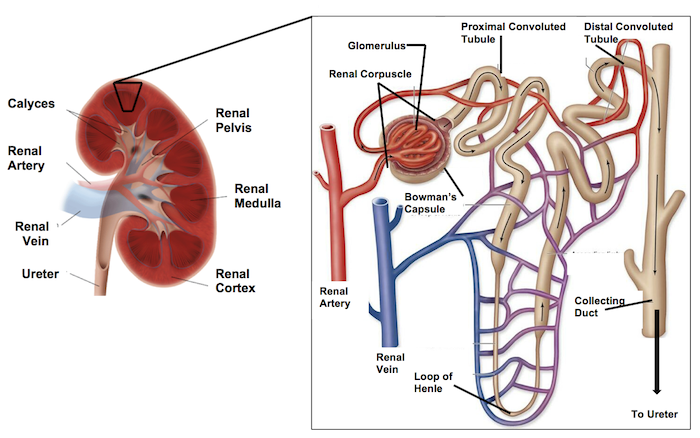What is proteinuria (protein in urine)?
A small amount of protein in the urine is normal. But higher levels of protein in urine (proteinuria) are almost always a sign of kidney disease (CKD, or AKI).
The kidneys are the bodys’ dustmen. They remove waste (from food), water and salts from the blood.
Protein is normally present in the blood. The blood flows into tiny filtering units in the kidney called glomeruli. Combined with the ‘tubule’ (where the filtered liquid is put), this is called a nephron.
 A nephron
A nephron
The glomeruli filter the blood, removing waste products. They also prevent some substances, such as protein, from being taken out of the blood. If the glomeruli are damaged, protein from the blood leaks into the urine.
What is normal, and abnormal?
To assess the protein level in the urine, you need a urine test called a urinary ACR (uACR). Normally, you should have an ACR of <3 mg/mmol. Having more than that is called ‘proteinuria’, or more technically ‘albuminuria’. Albumin is one of the proteins in the urine. This is a scale of what different levels of ACR:
- A1 <3 mg/mmol = normal
- A2 3-30 = low (also called ‘microalbuminuria’)
- A3 30-70 = low-moderate
- ACR 70-140 = moderate
“An ACR>140 is strongly suggestive of glomerular cause (and often called ‘nephrotic range)”
- ACR 140-220 = high
- ACR >220 = very high. This level is part of the way doctors diagnose ‘nephrotic syndrome’ (see below)
- ACR > 280 = extremely high.
| Dipstick | g/24h | g/L | PCR | ACR | Level | Type |
| 0 | <0.15g | <0.075g | <5 mg/mmol | <3 mg/mmol | Normal | |
| Microalb | 3-30 | Low | Glom/Tubular | |||
| Trace | 1.0 | 0.5 | 50 | 30 | Low-moderate | Glom/Tubular |
| 1 | 2.0 | 1.0 | 100 | 70 | Moderate | Usually glomerular |
| 2 | 4.0 | 2.0 | 200 | 140 | High (nephrotic range) | Always glomerular |
| 3 | 6.0 | 3.0 | 300 | 220 | Very high (nephrotic syndrome) | |
| 4 | 8.0 | 4.0 | 400 | 280 | Extremely high |
Symptoms
Usually there are no symptoms are associated with protein in the urine. However, if your body is losing a large amount of protein, your urine may become foamy, and you may get swelling in your hands, feet, face, eyes or abdomen.
Proteins help soak up necessary fluid for your body. When your protein levels are significantly lower than they should be, you struggle to absorb fluids sufficiently and swelling may occur.
Causes of proteinuria
It can be caused by many diseases that affect the kidney function, either in the long term (chronic kidney disease, CKD) or short term (acute kidney injury, AKI). Or it can occur with normal kidney function.
Higher levels of proteinuria (i.e. with a higher ACR)
This is especially is linked to kidney diseases that affect the glomeruli (called glomerular disease), mainly:
- Diabetes, causing diabetic nephropathy (most common cause of proteinuria)
- Chronic (long term) glomerulonephritis (‘GN’; rarely), of which there are 7 types.
Lower levels of proteinuria
- Urine infection (urinary tract infection, UTI) – can cause (low level) proteinuria, but usually there are other signs of the infection
- Sign of another condition – e.g. chronic heart failure (CCF), or a first warning of pre-eclampsia in pregnancy
- Temporary proteinuria – may occur after vigorous exercise or if you have a high fever
- Orthostatic proteinuria. Sometimes, usually in children, proteinuria can be detected later in the day, but not in the morning. This is usually harmless.
Nephrotic syndrome
Nephrotic syndrome occurs when there are very high levels of proteinuria. Nephrotic syndrome is diagnosed by:
- A urine ACR of over 220 mg/mmol
- A low albumin level (less than 30 g/L) in the blood
- Ankle swelling.
It is usually due to diabetes or more rarely, a chronic (long-term) glomerulonephritis (GN). This is a group of autoimmune diseases, that usually needs a kidney (renal) biopsy to diagnose. CKDEx has more information on what a kidney biopsy is like.
Treatment
Protein in urine almost always indicates kidney trouble. Treatment includes:
- Reducing protein levels in urine – we use tablets whose primary function is to treat high blood pressure or diabetes to reduce the level of protein in the urine:
- ACE inhibitors (e.g. Ramipril) and ARB antagonists (e.g. Losartan) – are blood pressure tablets that have a special effect on the kidneys as they reduce protein levels in the urine
- Sodium-glucose cotransporter 2 (SGLT2) inhibitors (e.g. Dapagliflozin) – are a newish class of diabetes tablets that reduce blood glucose levels by increasing the removal of glucose in the urine. But they have also been shown to be useful for many patients with CKD, especially if there is alot of protein in your urine (with or without diabetes)
Note. the combination of the two types of drugs is especially effective
- Treating the underlying disease – for example, controlling diabetes better, or suppressing the immune system if a kidney biopsy shows a GN.
Note. In some patients ACEs, ARBs and SGLT2is can make kidney function worse. If in doubt discuss this with your GP and kidney specialist.
Summary
We have described what is proteinuria (protein in urine). We hope you understand it better now.
Other resource
Here is more information on proteinuria.
Last Reviewed on 9 May 2024
